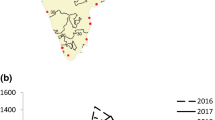Abstract
Forecasting severe weather events is of immense value since it can help alleviate (if not mitigate) the disastrous impacts to a certain extent. While accurate and precise forecasting is a great challenge, the advances in recent decades in the NWP in India have shown improved accuracy and reliability in the forecasting capabilities, especially for severe weather events. Improved observations, monitoring, modelling and forecasting capabilities in recent years in India have helped in early detection and warning for severe weather events. This Chapter documents the recent developments in India, and NCMRWF in particular, in forecasting (i) Heavy Rainfall (ii) Tropical Cyclones (iii) Thunderstorms and Hailstorms (iv) Heat and Cold Waves (v) Fog and Visibility.
Access this chapter
Tax calculation will be finalised at checkout
Purchases are for personal use only
Similar content being viewed by others
References
Ashrit R, Sharma K, Kumar S, Dube A, Karunasagar S, Arulalan T, Mamgain A, Chakraborty P, Kumar S, Lodh A, Dutta D, Momin I, Bushair MT, Prakash BJ, Jayakumar A, Rajagopal EN (2020) Prediction of the August 2018 heavy rainfall events over Kerala with high resolution NWP models. Meteorol Appl 27(2):1–14. https://doi.org/10.1002/met.1906
Gultepe I, Pagowski M, Reid J (2007) Using surface data to validate a satellite based fog detection scheme. Weather Forecast 22:444–456
India Meteorological Department 2013: Cyclone Warning in India, Standard Operating Procedure, July 2013
Jenamani RK, Tyagi A (2011) Monitoring fog at IGI airport and analysis of its runway wise spatio-temporal variations using Meso-RVR network. Curr Sci 100
National Disaster Management Authority 2016: Guidelines for Preparation of Action Plan—Prevention and Management of Heat-Wave
Petersen C, Nielsen NW (2000) Diagnosis of visibility in DMIHIRLAM. Scientific Report 00-11. DMI, Copenhagen, Denmark
Rosenfeld J (1996) Cars vs. the weather. A century of progress. Weatherwise 49:14–23
Smirnova TG, Benjamin SG, Brown JM (2000) Case study verification of RUC/MAPS fog and visibility forecasts. In: Preprints for 9th conference on aviation, range, and aerospace meteorology, Orlando, FL. American Meteorological Society, Boston, pp 31–36
World Meteorological Organization, 2016: Guide to Climatological Practices, 2nd edn. WMO-182
Author information
Authors and Affiliations
Corresponding author
Editor information
Editors and Affiliations
Rights and permissions
Copyright information
© 2023 Indian National Science Academy
About this chapter
Cite this chapter
Ashrit, R. et al. (2023). Forecasting of Severe Weather Events Over India. In: Gahalaut, V.K., Rajeevan, M. (eds) Social and Economic Impact of Earth Sciences. Springer, Singapore. https://doi.org/10.1007/978-981-19-6929-4_6
Download citation
DOI: https://doi.org/10.1007/978-981-19-6929-4_6
Published:
Publisher Name: Springer, Singapore
Print ISBN: 978-981-19-6928-7
Online ISBN: 978-981-19-6929-4
eBook Packages: Earth and Environmental ScienceEarth and Environmental Science (R0)




